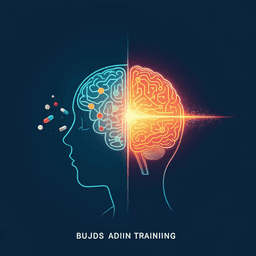
Psychology
Effects of a digital self-efficacy training in stressed university students: A randomized controlled trial
J. Rohde, M. A. Marciniak, et al.
Research conducted by Judith Rohde, Marta A. Marciniak, Mirka Henninger, Stephanie Homan, Anja Ries, Christina Paersch, Olivia Friedman, Adam D. Brown, and Birgit Kleim tested a one-week digital self-efficacy training prompting daily recall of mastery experiences. Compared to EMA-only control, it reduced hopelessness and trait anxiety and increased self-efficacy in stressed university students.
~3 min • Beginner • English
Introduction
Self-efficacy, the belief in one’s ability to exercise control over environment, thoughts, emotions, and behavior, is linked to positive mental health outcomes and resilience. It influences motivation, effort, and coping with social and professional challenges. University students frequently experience elevated stress, which is associated with poorer academic outcomes and higher risk of mental disorders. Higher self-efficacy in students relates to better academic performance, coping, lower anxiety, and greater hope, life satisfaction, and positive affect. Experimental induction of self-efficacy via false feedback and autobiographical memory-based strategies improves cognitive and affective processes, including reappraisal, future thinking, decision-making, and neural correlates of emotion regulation. Digital and mobile health interventions (EMIs), particularly when combined with EMA, offer scalable, resource-efficient ways to deliver psychological training in daily life. The study aimed to develop and test a week-long ecological momentary intervention to enhance self-efficacy through repeated recall of idiographic mastery experiences, hypothesizing improvements in self-efficacy and secondary outcomes (anxiety, stress, hopelessness, hope, positive and negative affect) compared to EMA-only. The study also explored baseline predictors of training efficacy, anticipating between-person variability.
Literature Review
Prior work shows self-efficacy as protective against distress and promotive of adaptation during adversity (e.g., pandemics), associated with stress resilience and daily stress buffering. In student populations, self-efficacy relates to improved academic outcomes and reduced anxiety and depression risk, with positive associations to hope and life satisfaction and inverse relations to negative affect. Experimental manipulations using false feedback suggest higher self-efficacy enhances social problem-solving and autobiographical memory performance. Autobiographical mastery memory recall improves reappraisal of negative events and future thinking/decision-making, with neural changes in executive and emotion regulation circuits observed in clinical samples. Traditional trainings include multi-session in-person skills programs; however, mobile and digital interventions provide scalable delivery, with EMIs often enhanced by EMA. Digital psychotherapeutic exercises (e.g., recording daily positive events) have improved self-efficacy and job performance; recalling self-efficacious memories digitally reduced COVID-19-related fear. Self-efficacy can mediate effects of digital psychotherapy on stress and anxiety even when not directly targeted. The current study leverages these findings by directly targeting self-efficacy via daily, digital recall of autobiographical mastery experiences within an EMI framework.
Methodology
Design: Randomized controlled trial comparing a digital self-efficacy training plus EMA (training group) to EMA-only (control). Ethical approval from University of Zurich Ethics Committee (No. 20.4.24). Trial registered retrospectively (ClinicalTrials.gov Identifier: NCT05617248). Delivery via SEMA3 smartphone platform; baseline and post assessments online.
Participants: Recruitment from Swiss universities during COVID-19 waves (05/2020–11/2020). Inclusion: enrolled at a Swiss university, age 18–29, smartphone owner, fluent German, Perceived Stress Scale (PSS-10) score ≥13. Exclusion: current psychiatric disorder. Randomized n=183 (training n=97; control n=86). Received intervention: training n=61, control n=46. Analysis included participants with app response rate >25% and completed post-assessment; final analyzed sample n=93 (training n=54; control n=39); 78% female; mean age 23.3 (SD 3.49).
Assessments:
- Screening: PSS-10 and demographics.
- Baseline: BDI-II (depression), STAI State and Trait (anxiety), PANAS Positive/Negative (affect), BHS (hopelessness), GSE (general self-efficacy), THS (trait hope). Internal consistencies were good to excellent across measures.
Interventions:
- Self-efficacy training (training group): Psychoeducation via a 4:22-minute video; define and record two autobiographical mastery memories (titles and brief descriptions). Daily imagination tasks with slow breathing and stepwise recall focusing on traits/qualities used to overcome challenges. Schedule: three training sessions per day for seven days; prompted within fixed 30-minute intervals, available for 50 minutes; extra on-demand training+EMA sessions accessible via app button. Memory focus: Day 1 memory one; Day 2 memory two; alternation; Day 7 participant choice. Common memory content included academic successes, overcoming social challenges, and sports achievements. Evening questions on specific self-efficacy (not analyzed here).
- EMA (both groups): Ten prompts per day for seven days assessing mood, social contacts, and virtual context (e.g., “I feel cheerful,” “I feel irritated,” 1–7 scale). In the training group, three daily EMA sets were combined with training; additional on-demand EMA available.
- Post-assessment: Same as baseline plus PSS and uMARS (German version) for app evaluation; to be completed within 3 days.
Compliance: Defined as responded push notifications out of scheduled tasks plus extra sessions. Compliance=1 indicates completion of all 70 scheduled tasks; >1 includes extra tasks. Mean compliance: training 0.72 (SD 0.18), control 0.79 (SD 0.25); overall range 0.28–1.46.
Blinding: Participants blinded to group; staff not blinded; communications standardized.
Statistical analysis: Alpha=0.05. Step 1: Multivariate linear model regressing difference scores (post minus baseline) for GSE, BHS, STAI State/Trait, PSS, PANAS Positive/Negative, THS on group and compliance, allowing correlations among outcomes; unstandardized coefficients (b) reported. Step 2: Multiple linear regression predicting GSE difference from baseline GSE, group, and interactions of baseline GSE with baseline BHS, THS, STAI State/Trait, PANAS Positive/Negative, PSS, BDI-II. Software: R 4.0.2, Mplus 8.6 (via MplusAutomation), SPSS 27; data and code available on OSF. Power analysis: For α=0.05, power=80%, effect size d=0.6, target n=94.
Key Findings
- Sample: 93 participants analyzed (training n=54; control n=39); 78% female; mean age 23.3 (SD 3.49). No baseline group differences in demographics or clinical measures (all p≥.05).
- Primary/secondary outcomes (multivariate model): Training group showed significantly greater reductions from baseline to post in:
• Hopelessness (BHS): b = -0.06, SE = 0.03, p = .02, β = 0.24.
• Trait anxiety (STAI-Trait): b = -0.18, SE = 0.06, p = .003, β = -0.30.
No significant group effects were observed for STAI-State, PSS, PANAS Positive/Negative, THS, or GSE when not controlling for baseline GSE.
- Self-efficacy change conditional on baseline:
• Lower baseline GSE predicted greater increases in GSE across both groups: b = -0.26, SE = 0.09, p = .003, β = -0.31.
• This effect was significantly stronger in the training group vs control: b = 0.15, SE = 0.07, p = .02, β = 0.21.
- Baseline predictors of GSE change (with baseline GSE in model):
• Higher baseline hopelessness associated with greater GSE increase: b = 2.68, SE = 0.64, p < .001, β = 0.97.
• Higher baseline perceived stress associated with greater GSE increase: b = 0.39, SE = 0.18, p = .03, β = 0.31.
• Higher baseline depression associated with smaller GSE change: b = -1.37, SE = 0.37, p < .001, β = 0.93.
• Higher baseline negative affect associated with smaller GSE change: b = -0.44, SE = 0.22, p = .049, β = -0.38.
- Compliance: Training group mean 0.72 (SD 0.18); Control 0.79 (SD 0.25). No harms or unintended effects reported.
Discussion
The week-long digital self-efficacy training integrated into daily life significantly reduced hopelessness and trait anxiety compared to an EMA-only control among stressed university students. While overall post-training self-efficacy differences by group were not significant, controlling for baseline self-efficacy revealed that participants with lower baseline GSE experienced larger gains, with stronger effects in the training group. Baseline hopelessness and perceived stress were associated with greater improvements in self-efficacy, whereas baseline depression and negative affect predicted smaller gains. These findings support the hypothesis that targeted recall of autobiographical mastery experiences can beneficially influence mental health outcomes and self-efficacy, particularly for individuals starting with lower self-efficacy. The training appears safe and acceptable, with no adverse events reported. Methodologically, measuring general self-efficacy (GSE) immediately post-intervention may under-detect specific, domain-level changes induced by idiographic memory content; future assessments may benefit from domain-specific measures or delayed follow-up. Overall, the results suggest digital self-efficacy interventions can serve as scalable tools to reduce hopelessness and anxiety and enhance self-efficacy, especially in populations with elevated stress.
Conclusion
A stand-alone, week-long digital self-efficacy training, delivered via smartphone and centered on repeated recall of autobiographical mastery experiences, produced significant reductions in hopelessness and trait anxiety in a stressed student population and enhanced self-efficacy among those with lower baseline self-efficacy. The intervention was well tolerated. Future research should replicate findings in more heterogeneous and clinical samples, examine long-term sustainability of effects, refine measurement to capture domain-specific self-efficacy changes, and evaluate integration into clinical pathways (e.g., pre-treatment engagement to bridge waiting periods) to improve outcomes and therapy readiness.
Limitations
- No long-term follow-up assessments; durability of effects unknown.
- Conducted during COVID-19 pandemic with elevated stress; limits causal attributions and generalizability beyond this context.
- Potential additional active ingredients (e.g., EMA engagement) may have contributed to changes; both groups engaged in EMA.
- Homogeneous sample in education, sex, and origin; broader cultural and clinical populations needed.
- Group sizes imbalanced but baseline equivalence observed; potential impact limited.
- Slight underpower relative to target (n=93 vs n=94).
- High pre-baseline dropout; per-protocol analysis only, no intention-to-treat.
- Retrospective trial registration.
- General Self-Efficacy Scale may be less sensitive to immediate, domain-specific changes induced by idiographic memory content.
Related Publications
Explore these studies to deepen your understanding of the subject.







